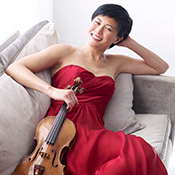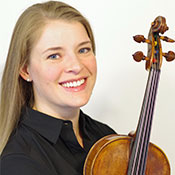
Leila Josefowicz On Performing New Works
David Lewellen
PUBLISHED
Tagged Under: 2023.24 Season, Guest Artist
Leila Josefowicz is OK with being known as the new-repertoire violinist.
“I don’t get asked to play Brahms very often,” she said recently by phone, before visiting Milwaukee to perform a piece written last year. “I’m known for playing new music in the industry. It’s also something that I know I’m especially good at.”
Josefowicz will be the soloist for Assonanza, composed for her by Matthias Pintscher, who will also be conducting the MSO. “It’s a great thing to come back to Milwaukee,” she said. “It’s probably been 10 years, and this collaboration is very special.”
Pintscher wrote the first version of the piece for solo violin during the pandemic, when only solos were practical, and Josefowicz recorded it at the Metropolitan Museum of Art (it begins at the 29-minute mark of this video). After events opened up again, Pintscher rewrote it as a concerto with orchestra. “I was curious to see what he did with it,” Josefowicz said. “Some of it directly quotes the solo version, and some of it is a complete departure.”
The piece “uses as many colors as can exist in the pianissimo dynamic. It opens you in a certain way,” she said. “You have to quiet your mind to be receptive to it. I love to perform his music because each composition is a different language. It’s a different stylistic turn.”
Josefowicz has commissioned many new works and performed many others of recent vintage. Solving the technical challenges of new compositions is “the basis of my playing,” she said. “It’s a totally different technique for each composer.”
What does she look for in a contemporary composer? “How many different kinds of color I can make on the violin,” she said. “Things that let me breathe and give me the freedom to make different colors.”
In musical terms, “color” means different aural qualities to the same note. “It can be floaty and soft, or gravelly, or gritty,” she said. “You can experiment with different colors, but each one has to produce an emotional feeling. You don’t produce colors just for the sake of colors. You have to figure out what the music is emotionally asking.”
Another benefit of playing contemporary music is that no one can complain online that Jascha Heifetz or Isaac Stern or Itzhak Perlman played it better. “That’s one reason I went this direction,” she said. “This competitive listening is not healthy. There’ll never be another Heifetz, so let’s explore how different performers can be.”
Repertoire that doesn’t sound like the mainstream tradition of the 18th and 19th centuries can sometimes be a hard sell to audiences, but it goes with the territory for Josefowicz. “I hope I’m convincing enough to make it work,” she said. “The music should arrest you upon listening if it’s great music and well-performed in a communicative way. I’m so convinced by what I’m doing that I hope I convince others. There’s no guarantee, but I hope.”
And as a passionate and convincing musician, “I want to challenge that notion of what we perceive as beautiful sound,” she added. “To me, colorful is beautiful and contrast is beautiful.”
Possibly as a ripple effect from the unrest of 2020, major orchestras have become more deliberate about adding living composers and composers of color to their programming. “It’s much more adventurous now and that’s something to feel great about,” Josefowicz said. “Almost every program now has something new-ish, at least, and that’s a big change from the ’80s and the ’90s.”
And even as she seeks out and encourages young composers, “It’s a wonderful treat to have this collaboration with Matthias,” she said. “I think it’s really exciting and I’m glad to be bringing it to you all.”



